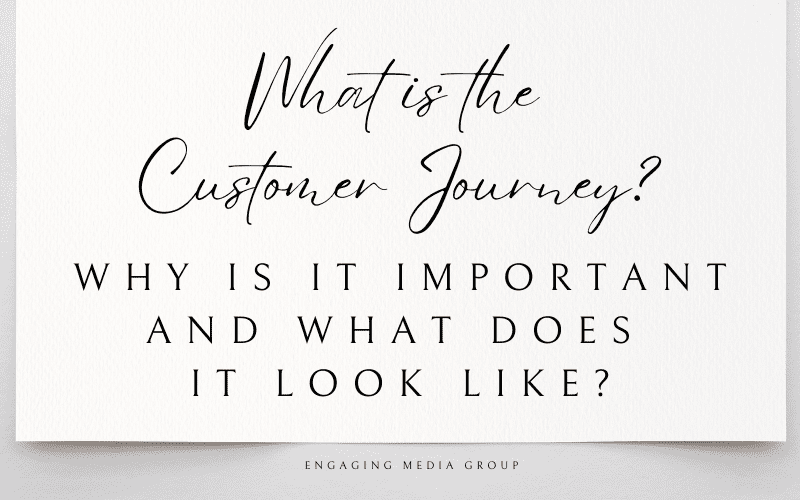The customer journey refers to the process and stages a customer goes through from initial awareness of a product or service to making a purchase decision and beyond. It encompasses all the interactions, touchpoints, and experiences a customer has with a business throughout their buying journey. Mapping out the customer journey is important because it allows businesses to gain a deeper understanding of their customers’ needs, preferences, and pain points at each stage. It helps businesses align their marketing strategies, optimize the customer experience, and improve the chances of driving successful conversions and fostering customer loyalty.
To optimize the customer journey, businesses can take the following steps:
- Research and Define Customer Personas: Conduct market research to identify and define your target audience segments. Create customer personas that represent your ideal customers, including demographic information, preferences, behaviors, and goals.
- Identify Touchpoints and Interactions: Determine all the touchpoints where customers interact with your brand, both online and offline. This includes website visits, social media engagement, email communications, customer service interactions, and more.
- Collect and Analyze Data: Utilize tools and techniques to collect data on customer behavior and preferences at each touchpoint. This data can include website analytics, social media insights, customer surveys, and feedback. Analyze the data to gain insights into customer preferences, pain points, and decision-making processes.
- Visualize the Customer Journey: Create a visual representation of the customer journey, such as a journey map or flowchart. This helps visualize the different stages and touchpoints, allowing businesses to see the overall customer experience and identify areas for improvement.
- Optimize Each Stage of the Journey: Once you have mapped the customer journey, focus on optimizing each stage to enhance the customer experience and drive conversions. Here are some strategies:
- Awareness and Discovery: Develop targeted content marketing strategies, optimize your website for search engines, and leverage social media platforms to increase brand awareness and attract potential customers.
- Consideration and Evaluation: Provide valuable information and resources to educate customers about your products or services. Use personalized email campaigns, product demos, testimonials, and case studies to influence their decision-making process.
- Conversion and Purchase: Streamline the conversion process by ensuring a user-friendly website, clear and compelling call-to-action (CTA), and secure payment options. Eliminate any friction or barriers that could hinder the purchase.
- Post-Purchase and Loyalty: Focus on delivering exceptional customer service, personalized communication, and post-purchase support. Implement loyalty programs, referral incentives, and ongoing engagement to foster long-term customer loyalty.
- Continuously Measure and Adapt: Regularly monitor and measure the effectiveness of your customer journey optimization efforts. Use analytics tools to track key metrics, collect feedback, and make data-driven decisions. Continuously adapt and refine your strategies based on customer insights and market trends.
By mapping and optimizing the customer journey, businesses can create a seamless and personalized experience for their customers. This improves customer satisfaction, increases conversions, and enhances brand loyalty, ultimately driving business growth and success.
What is the customer journey for Senior Living Businesses?
The customer journey for senior living businesses refers to the process and stages that individuals or families go through when considering and selecting a senior living community or care services for their loved ones. Here is an overview of the typical customer journey for senior living businesses:
Awareness Stage: At this stage, potential customers become aware of the need for senior living options. They may recognize signs that their loved ones require additional care, such as declining health, increased assistance needs, or safety concerns. They start researching and seeking information about senior living communities and care services.
Research and Consideration Stage: During this phase, individuals and families conduct thorough research to evaluate various senior living options available to them. They explore different types of senior living communities, such as independent living, assisted living, memory care, or skilled nursing facilities. They gather information about amenities, services, location, pricing, and the level of care provided. They also read reviews, seek recommendations, and visit websites to gather as much information as possible.
Evaluation and Decision Stage: In this stage, potential customers narrow down their options and begin evaluating specific senior living communities. They may schedule tours, visit the facilities, and meet with staff members. They assess the quality of care, the environment, the available activities, and the overall atmosphere of each community. They may also consider factors like cost, proximity to family, and the community’s reputation. After careful consideration, they make a decision on which senior living option best meets their needs and preferences.
Move-in and Adjustment Stage: Once the decision is made, customers transition into the move-in and adjustment phase. They work closely with the senior living community to complete the necessary paperwork, arrange logistics, and prepare for the move. This stage involves acclimating to the new environment, getting to know staff members and fellow residents, and adjusting to the daily routines and activities within the community.
Ongoing Engagement and Satisfaction Stage: After moving in, the customer journey continues as residents and their families engage with the senior living community on an ongoing basis. This includes participating in community activities, utilizing the available services and amenities, and building relationships with staff and other residents. Customer satisfaction in this stage is crucial, as positive experiences and a high level of care contribute to long-term resident retention and potential referrals.
Understanding the customer journey for senior living businesses is vital for providing a seamless and personalized experience for potential residents and their families. By aligning marketing efforts and service delivery with each stage of the customer journey, senior living businesses can effectively engage with their target audience, address their concerns, and guide them toward making informed decisions that meet their unique needs and preferences.
What is the customer journey for Home Health Businesses?
The customer journey for home health businesses refers to the process that individuals and their families go through when seeking and receiving home health services. Here is an overview of the typical customer journey for home health businesses:
Awareness and Need Recognition: The customer journey begins when individuals or their families recognize a need for home health services. This may occur when someone faces a health issue, injury, or chronic condition that requires professional care and assistance at home. Awareness can also be generated through referrals from healthcare professionals, family members, or friends.
Research and Evaluation: In this stage, potential customers gather information and research different home health providers. They explore the services offered, such as skilled nursing, physical therapy, occupational therapy, or personal care assistance. They seek out information about the qualifications and expertise of the caregivers, the reputation of the agency, and the availability of services in their area.
Contact and Consultation: Once potential customers have narrowed down their options, they typically contact home health agencies to initiate the consultation process. This involves speaking with agency representatives, discussing their specific needs, and evaluating the agency’s ability to meet those needs. The agency may conduct an assessment of the individual’s health condition and develop a personalized care plan.
Decision and Contracting: After reviewing the information and recommendations provided by various home health agencies, the individual or their family makes a decision on which agency to engage with. This decision is based on factors such as the agency’s reputation, services offered, caregiver qualifications, cost, and the compatibility of the care plan with the individual’s needs. Contracts and agreements are then signed to formalize the engagement between the individual and the home health agency.
Service Provision and Care Delivery: This stage involves the actual provision of home health services. Caregivers are assigned to the individual’s home and begin delivering the agreed-upon services, such as administering medication, providing therapy, assisting with activities of daily living, or offering companionship. The home health agency works closely with the individual and their family to ensure the delivery of quality care and address any evolving needs or concerns.
Ongoing Support and Monitoring: Throughout the duration of the home health services, the agency maintains regular communication with the individual and their family to monitor the progress of care, address any issues or changes, and ensure satisfaction with the services provided. This ongoing support helps maintain a high level of customer satisfaction and ensures that the care plan remains aligned with the individual’s evolving needs.
Understanding the customer journey for home health businesses is crucial for delivering a seamless and personalized experience. By focusing on each stage of the customer journey and providing exceptional care and service, home health businesses can effectively meet the needs of their clients, build trust and long-term relationships, and contribute to the overall well-being and quality of life of individuals receiving home health services.

